Removal Procedure
Tools Required
| • | J 24402-A Glass
Sealant Remover (Cold Knife), or equivalent |
| • | J 39032 Stationary
Glass Removal Kit, or equivalent |
| • | GM P/N 12346392 Urethane Adhesive Kit, or equivalent |
| • | Isopropyl alcohol or equivalent |
| • | Cartridge-type caulking gun |
| • | Commercial-type utility knife |
Notice: DO NOT close the lift window panel with the struts attached unless
the window is installed and the window adhesive fully cured. The window adds
strength and rigidity to the lift window panel. Attempting to close the lift
window panel, with the struts installed, without a window or with
the window adhesive not fully cured, could cause the panel to crack.
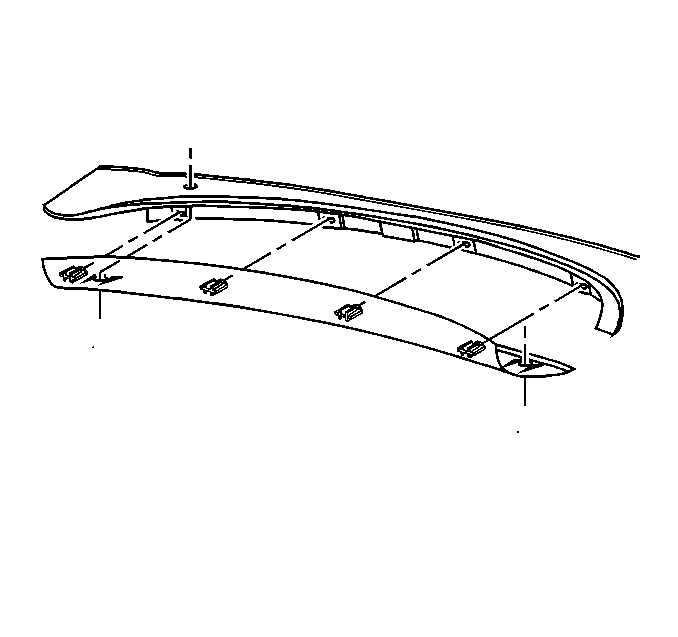
- Install a protective cover
inside the vehicle.
- Remove the lower garnish molding and the rear compartment front
side trim panel for access to the inside of the window. Refer to
Rear Compartment Side Trim Panel Replacement
.
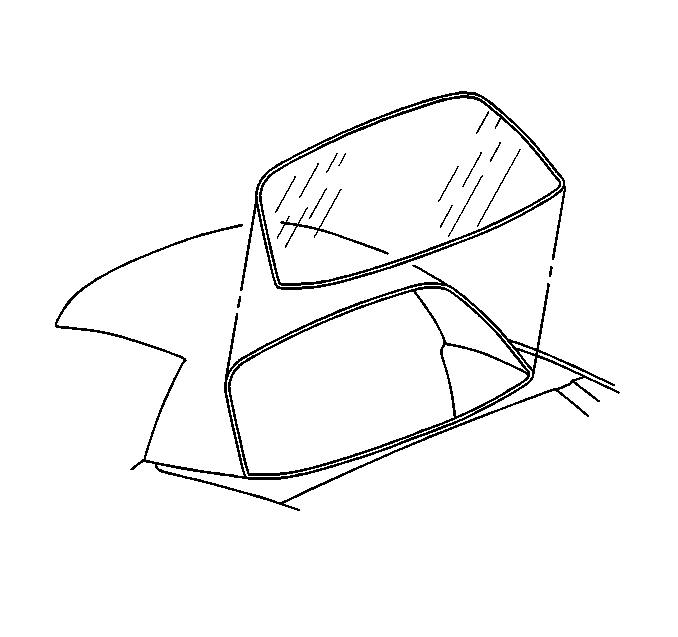
- Remove the rear window
defogger connectors from the window.
Caution: When working with any type of glass or sheet metal with exposed or rough
edges, wear approved safety glasses and gloves in order to reduce
the chance of personal injury.
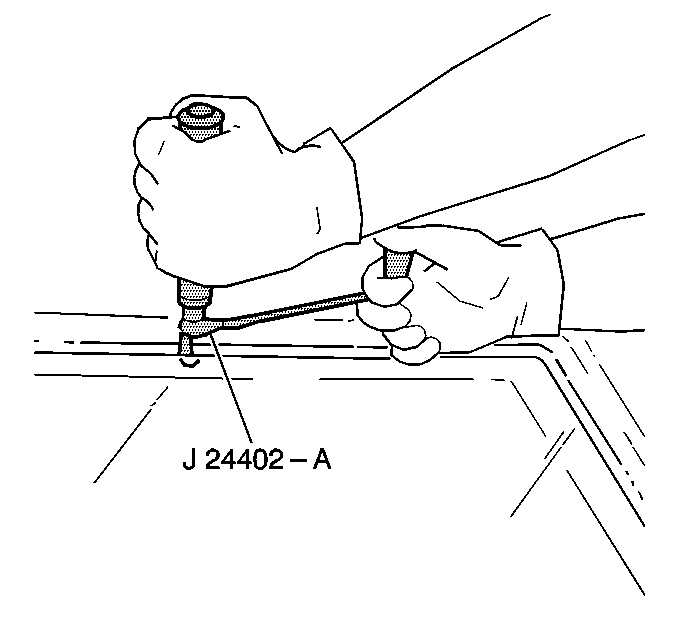
Important: Keep the cutting edge of the tool against the rear window when removing
the rear window. This will allow the urethane adhesive to be separated from
the rear window. Leave a base of urethane on the pinchweld flange. The only
suitable lubrication is clear water.
- Use the J 24402-A
or J 39032
in order to cut the rear window from the pinchweld
flange. Do this from inside the vehicle in order to protect the outer paint
surface.
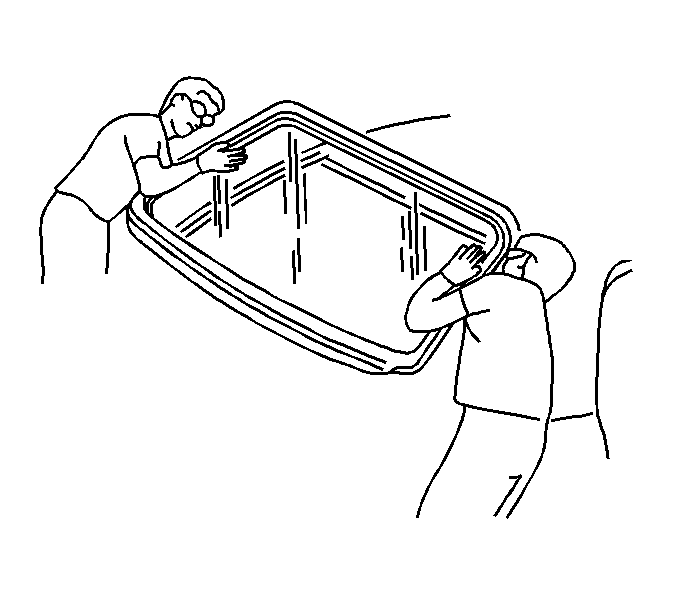
- With the aid of an assistant, use the
suction cups in order to lift the rear window from the opening.
- Inspect the following components for the causes of a broken rear
window:
| • | The flange of the rear window opening |
| • | The rear window reveal molding |
- Inspect for any of the following problems in order to help prevent
future breakage of the rear window:
| • | Hardened spot weld sealer |
| • | Any other obstruction or irregularity in the pinchweld flange. |
Important: If corrosion of the pinchweld flange is present, or if sheet metal repairs
or replacements are necessary, refinish the pinchweld flange in order to present
a clean primer only surface. If paint repairs are required, mask the flange
bonding area prior to the application of the color coat in order to provide
a clean primer only surface. Materials such as BASF DE17®, DuPont 2610®,
Sherwin-Williams PSE 4600 and NP 70 and Martin-Semour 5120 and
5130 products are approved for this application.
- After repairing the opening as indicated, perform the following steps:
- Inspect the condition of the rear window opening and the urethane
adhesive bead in order to determine which installation method you will use.
Refer to
Short Method Description
or
Extended Method Description
for the guidelines.
- Remove all traces of broken glass from the vehicle.
- Clean around the edge of the inside surface of the rear window
with a 50/50 mixture of isopropyl alcohol and water by volume on a dampened
lint free cloth.
Installation Procedure
Caution: When working with any type of glass or sheet metal with exposed or rough
edges, wear approved safety glasses and gloves in order to reduce
the chance of personal injury.
Notice: Until the new urethane has cured, air pressure from a closing door may
cause the stationary window to move causing a leak. To prevent this, lower
a window before closing the door.
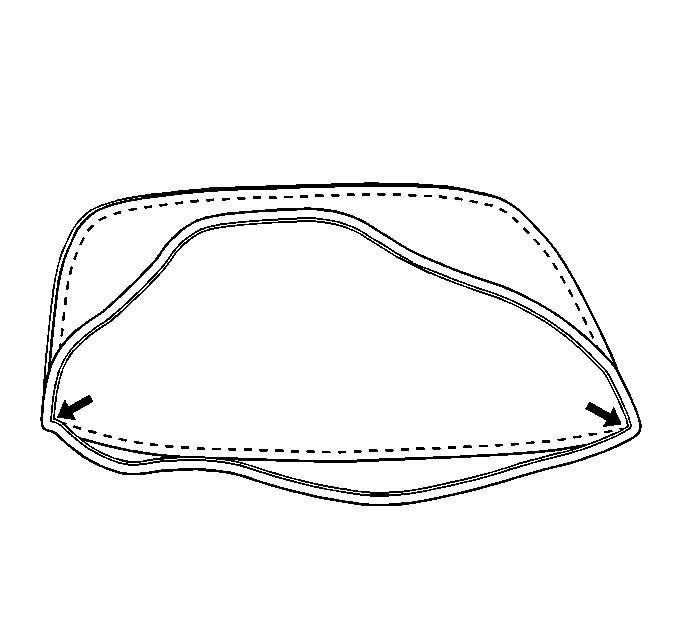
- Starting with the lower molded corners
of the reveal molding, install the reveal molding to the window.
- After repairing the opening as indicated, perform the following:
- Shake the pinchweld primer (black #3) for at least one
minute.
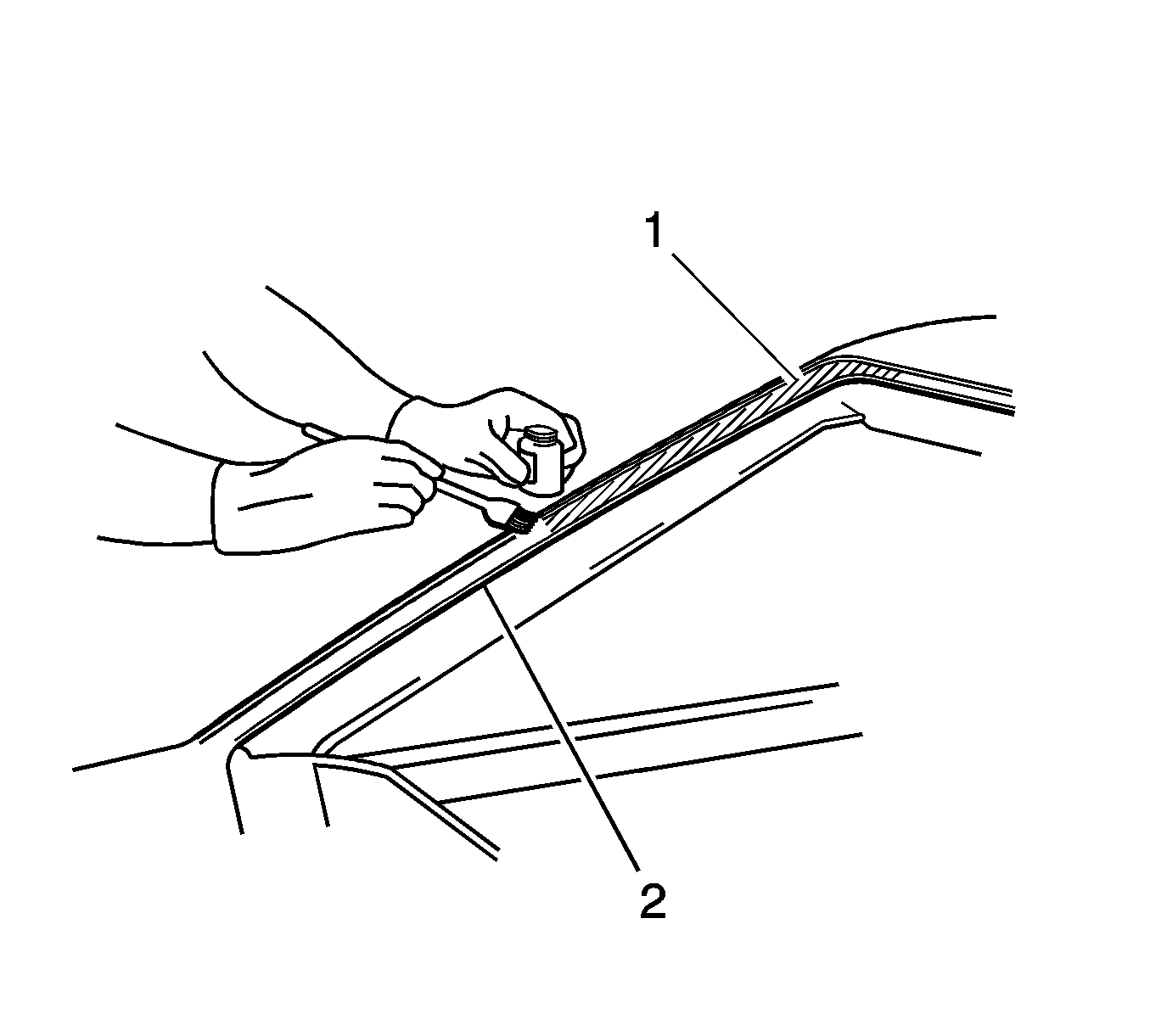
- Use a new dauber to apply the pinchweld
primer (black #3) to the surface of the bonding area.
- Allow the primer to dry for approximately 10 minutes. Ensure
that all nicks and scratches are covered.

- With the aid of an assistant, dry fit
the rear window in the opening in order to determine the correct way to position
the rear window in the opening.
- Use masking tape in order to mark the location of the rear window
in the opening.
- Slit the masking tape at the top edge of the rear window.

- With the aid of an assistant and the
rubber suction cups, remove the rear window.
- Place the rear window inside up on a clean, protected surface.
- If the original rear window is being reused, remove all but approximately
2 mm (3/64 in) of the existing urethane adhesive from the rear
window surface, using a utility knife or razor blade scraper.
- Clean around the edge of the inside surface of the rear window
with a 50/50 mixture of isopropyl alcohol and water by volume on a dampened
lint free cloth.
Important: Do not remove all traces of the adhesive. Remove all mounds or loose
pieces of urethane adhesive .
- If the extended method is being used remove all but approximately 2
mm (3/64 in) of the existing bead of adhesive from the pinchweld
flange.
- Shake the pinchweld primer (black #3) for at least one
minute.
- Use a new dauber to apply the primer to the surface of the pinchweld
flange.
- Allow the pinchweld primer to dry for approximately 10
minutes.
- If the extended method is being performed, do the following:

Important: Use care when applying the prep (clear #1) to rear window. This
primer dries almost instantly and may stain the viewing area of the rear
window if not applied evenly.
- If installing a new non encapsulated window:
| 18.1. | Use a new dauber, to apply the rear window prep (clear #3)
to an area approximately 10 to 16 mm (3/8 to 5/8 in) around
the entire perimeter of the rear glass inner surface. |
| 18.2. | Apply the rear window prep (clear #1) to the same area
of the glass. |
| 18.3. | Wipe the primed window area immediately with a lint-free cloth. |
| 18.4. | Shake the glass primer (black #2) for at least one minute. |
- If installing a new encapsulated window:
| 19.1. | Use a new dauber, to apply the rear window prep (clear #3)
to an area approximately 10 to 16 mm (3/8 to 5/8 in) around
the entire perimeter of the rear glass inner surface. The glass must be installed
within 8 hours after applying the primer to the glass. |
| 19.2. | The primed surface of the glass must be kept clean. |
| 19.3. | Allow the glass primer to dry for approximately 10 minutes. |
- Shake the rear window primer (black #2) for at least one
minute.
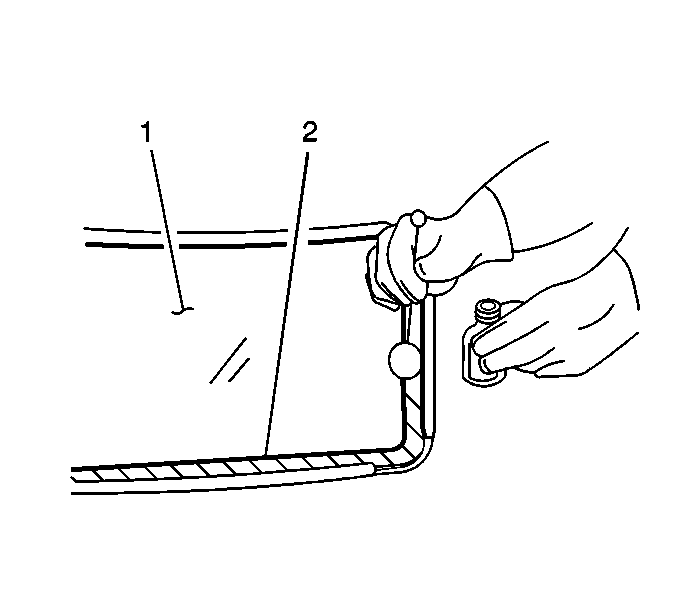
- Use a new dauber, in order to apply the
rear window primer (black #2) to the areas of the rear window (1)
to which prep (clear #1) was applied.
- Allow the primer to dry for approximately 10 minutes.
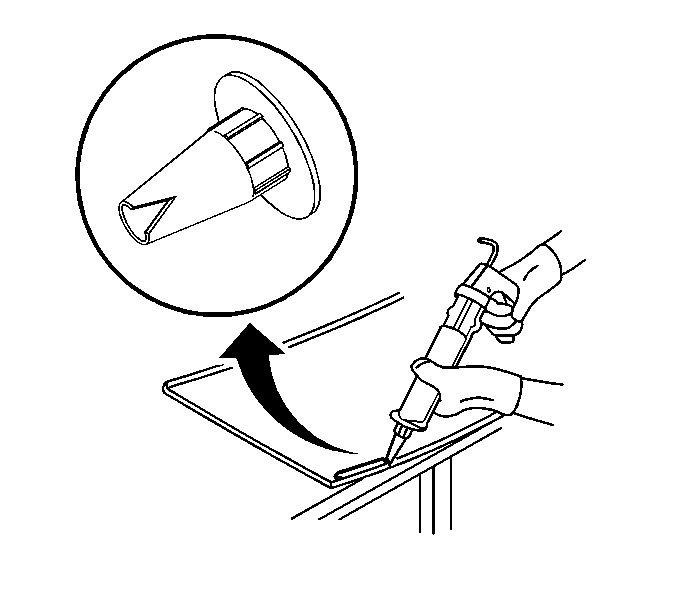
- If using the short method, cut the tip
of the applicator nozzle in order to provide a bead of 6.0 mm 1/4 in).
- If using the extended method, cut the applicator nozzle in order
to provide a bead 10.5 mm (0.14 in.) wide and 10.5 mm (0.14
in.) high.
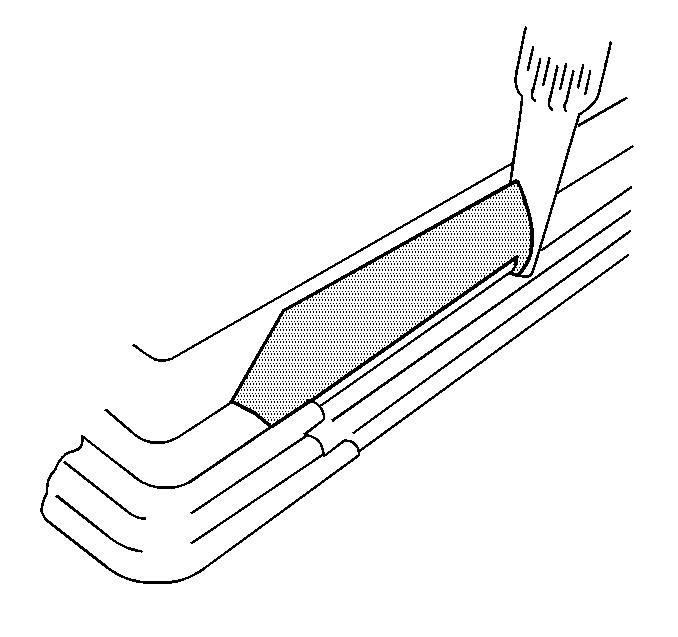
- Use a cartridge-type caulking gun, apply
a smooth continuous bead of new urethane adhesive around the edge of the
rear window where the primer was applied.
- When using the short method, apply the urethane adhesive to the
existing bead of urethane adhesive on the body.
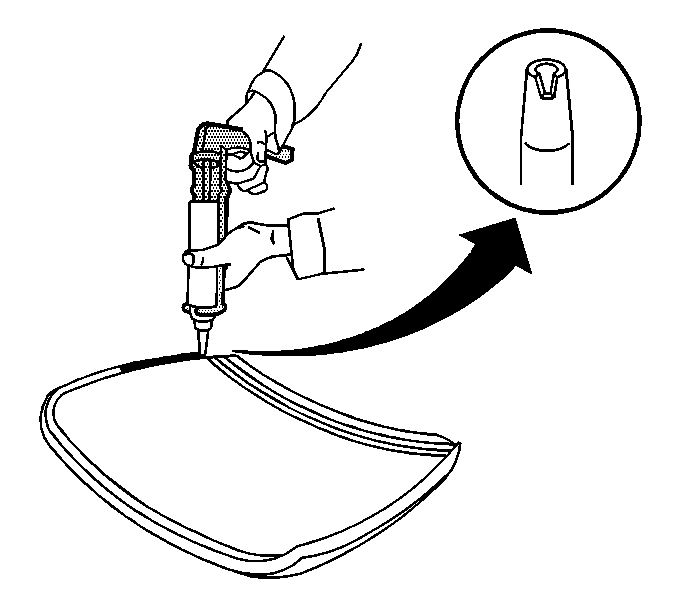
- When using the extended method, use the
edge of the rear window or the inside edge of the reveal molding as a guide
for the nozzle in order to apply the urethane adhesive to the inner surface
of the rear window.

- With the aid of an assistant, use the
suction cups in order to install the rear window into the opening.
- Align the tape on the rear window and on the body.
- Press the rear window firmly into place in order to wet-out and
seat the urethane adhesive.
- Tape the rear window in places to the body in order to minimize
movement until the urethane adhesive cures.
- Clean any excess urethane adhesive from the body.
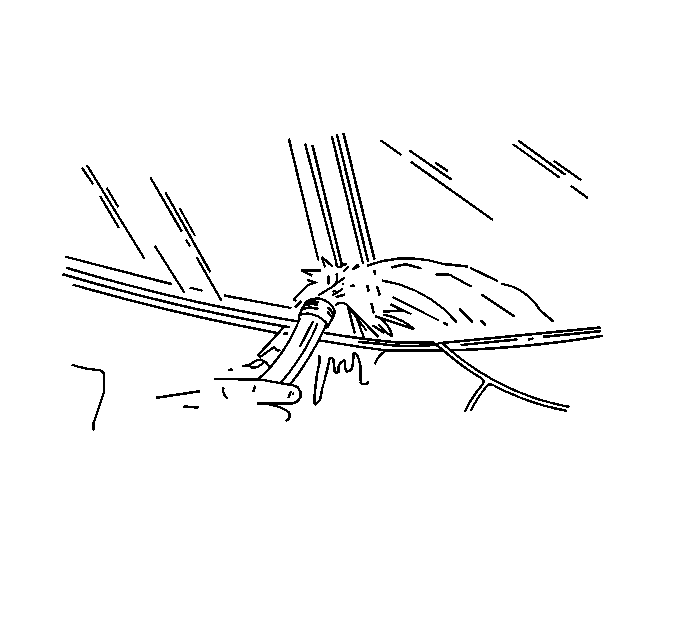
Important: Do not direct a hard stream of high pressure water at the fresh urethane
adhesive.
- Use a soft spray of warm water in order to immediately water test the
rear window.
- Inspect the rear window for leaks.
- If any leaks are found, use a plastic paddle in order to apply
extra urethane at the leak point.
- Retest the rear window for leaks.
- The following conditions must be maintained to properly cure the
urethane.
| 37.1. | Allow the vehicle to remain at room temperature (21°C or 70°F)
at 30 percent relative humidity. |
| 37.2. | Allow a minimum of 6 hours for the moisture curing urethane
adhesive. |
| 37.3. | Allow a minimum of 1 hour to 1 1/2 hours for the chemical
curing urethane adhesive. |
| 37.4. | Partially lower a door window in order to prevent pressure buildups
when closing doors before the urethane adhesive cures. |
| 37.5. | Do not drive the vehicle until the urethane adhesive is fully
cured. Refer to the above curing times. |
| 37.6. | Do not use compressed air in order to dry the urethane adhesive. |
- Connect the rear window defogger connections.
- Remove the interior protective cover.















